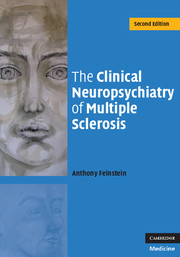Book contents
- Frontmatter
- Contents
- Acknowledgement
- Foreword
- 1 Multiple sclerosis: diagnosis and definitions
- 2 Depression: prevalence, symptoms, diagnosis and clinical correlates
- 3 Depression: etiology and treatment
- 4 Multiple sclerosis, bipolar affective disorder and euphoria
- 5 Multiple sclerosis and pseudobulbar affect
- 6 Multiple sclerosis and psychosis
- 7 Cognitive impairment in multiple sclerosis
- 8 The natural history of cognitive change in multiple sclerosis
- 9 Cognitive impairment in multiple sclerosis: detection, management and significance
- 10 Neuroimaging correlates of cognitive dysfunction
- 11 Multiple sclerosis, disease-modifying treatments and behavioral change
- 12 Multiple sclerosis: a subcortical, white matter dementia?
- Index
- Plate section
- References
3 - Depression: etiology and treatment
Published online by Cambridge University Press: 13 August 2009
- Frontmatter
- Contents
- Acknowledgement
- Foreword
- 1 Multiple sclerosis: diagnosis and definitions
- 2 Depression: prevalence, symptoms, diagnosis and clinical correlates
- 3 Depression: etiology and treatment
- 4 Multiple sclerosis, bipolar affective disorder and euphoria
- 5 Multiple sclerosis and pseudobulbar affect
- 6 Multiple sclerosis and psychosis
- 7 Cognitive impairment in multiple sclerosis
- 8 The natural history of cognitive change in multiple sclerosis
- 9 Cognitive impairment in multiple sclerosis: detection, management and significance
- 10 Neuroimaging correlates of cognitive dysfunction
- 11 Multiple sclerosis, disease-modifying treatments and behavioral change
- 12 Multiple sclerosis: a subcortical, white matter dementia?
- Index
- Plate section
- References
Summary
In Ch. 2, data were presented defining the phenomenology of depression associated with MS. This is an essential precursor to studies that have explored the etiology of mood change. Indeed, some of the difficulties in determining which symptoms most accurately reflect mood change in MS patients may account, in part, for the inconsistencies in the neuroimaging data. It is, therefore, no coincidence that as symptom clarification proceeds in tandem with advances in neuroimaging brain–behavior correlations have become more robust.
This chapter will explore, first, putative etiological factors in relation to depression, namely genetics, brain imaging changes, endocrine dysfunction, immune system abnormalities and diverse psychosocial theories. Thereafter, a review of treatment modalities for depressed MS patients will be presented.
Etiology of depression in multiple sclerosis
The pathogenesis of the major depressive-like disorders frequently experienced by MS patients is unclear. Research has been undertaken to examine mood and MS using genetics, structural and functional neuroimaging, endocrine and immune system markers and social variables, and a mixed picture has emerged. The reasons for these partial successes and failures are reviewed and future research options suggested.
Genetics and depression
Evidence suggesting a genetic link between MS and unipolar depression is mixed. Based on the family history method, Joffe et al. (1987) did not find an excess of affective illness in the first-degree relatives of patients with MS, a finding in agreement with others (Minden et al., 1987; Schiffer et al., 1988).
- Type
- Chapter
- Information
- The Clinical Neuropsychiatry of Multiple Sclerosis , pp. 46 - 65Publisher: Cambridge University PressPrint publication year: 2007



